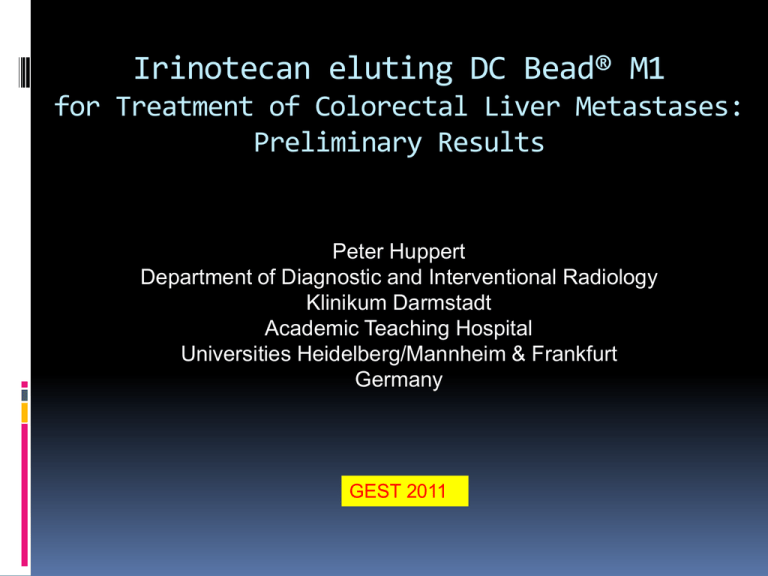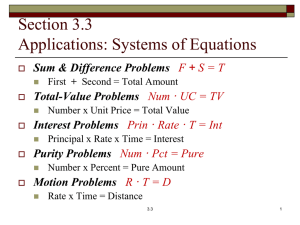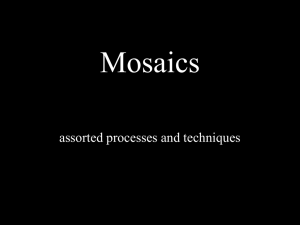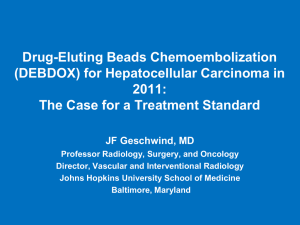
Irinotecan eluting DC Bead® M1
for Treatment of Colorectal Liver Metastases:
Preliminary Results
Peter Huppert
Department of Diagnostic and Interventional Radiology
Klinikum Darmstadt
Academic Teaching Hospital
Universities Heidelberg/Mannheim & Frankfurt
Germany
GEST 2011
TACE of Colorectal Cancer Liver Metastases
pts.
line
drugs
embx.
30
SL
C/D/M
collagen
n.r.
n.r.
Leichman `99 31
FL
C/D/M
collagen
29
8
14
Salman `02
24
SL
FU/INF
PVA
21
n.r.
11
Müller ´03
66
FSL
FU/Mel IO/GF
43
8
8
Hong ´09
21
FSL
C/D/M
n.r.
n.r.
8
Vogl `09
463
SL
M/Gem/I IO/DSM
15*
n.r.
14
Albert `10
121
SL
C/D/M
3
9
Tellez `98
PVA
IO/PVA
ORR(%) PFSV(mo)
2*
Drugs: C= Cisplatin; D=Doxorubicin; M=Mitomycin C; FU=5-FU;
INF=Interferon; Mel=Melphalan; Gem= Gemcitabin, I=Irinotecan;
mOSV (mo)
9
*RECIST
TACE of Colorectal Cancer Liver Metastases
pts.
line
drugs
embx.
30
SL
C/D/M
collagen
n.r.
n.r.
Leichman `99 31
FL
C/D/M
collagen
29
8
Tellez `98
ORR(%) PFSV(mo)
mOSV (mo)
9
14
Salman
24 SL of local
FU/INF
PVA
21
n.r. HAI studies
11
-No`02
improvement
oRR compared
to historical
Müller ´03
66
FSL
FU/Mel IO/GF
43
8
8
-No comparative studies to systemic treatment in SL setting
Hong ´09
21
FSL
C/D/M
PVA
n.r.
n.r.
8
VoglT.P.
`09 Pwint
463
SL roleM/Gem/I
IO/DSM 15* in liver
n.r. metastases
14from
: „…the
of chemoembolization
CRC
(Semin Oncol
Albert
`10has not
121 been
SL established.“
C/D/M IO/PVA
2* 2010;37:149-159)
3
9
-rationale for Irinotecan eluting Microspheres
Drugs: C= Cisplatin; D=Doxorubicin; M=Mitomycin C; FU=5-FU;
INF=Interferon; Mel=Melphalan; Gem= Gemcitabin, I=Irinotecan;
*RECIST
Regional Advantage of i.a. Irinotecan
Rart =
CL
QA (1 - Er )
Rart : advantage of IA vs IV
CL : total body clearance
QA : arterial flow
Er :extraction ratio /1st pass
Regional Advantage of i.a. Irinotecan
Rart =
CL
QA (1 - Er )
Rart : advantage of IA vs IV
CL : total body clearance
QA : arterial flow
Er :extraction ratio /1st pass
Drug
% Liver
extraction
Clearance
TB (l/min)
5-FU
22-45
2-5
FUDR
69-92
5-15
IRINOTECAN
38-72
9-25
MITO-C
7-18
3-5
CDDP
8-50
0.3-0.5
DOXO
45-50
-
DC Beads +
Irinotecan®
PVA macromere
backbone
Hydrated Beads
Grafting
point
DC Bead before irinotecan loading
Drug-loaded Beads
Irt+
DC Bead after irinotecan loading
SO3-
SO3-
Irt+
SO3-
SO3SO3-
Sulfonated
polymer chain
backbone
Irinotecan
Solution
SO3SO3-
SO3SO3-
SO3-
SO3-
SO3
SO3-
Irt+
Irt+
SO3-
Irt+
Bulk
Hydration shell
associated with PVA and (non-bound)
water
ionic groups
SO3-
Irt+
SO3-
Irt+
SO3-
Irt+
Irt+
SO3-
SO3SO3-
SO3SO3-
Irt+
SO3SO3-
-
SO3-
Irt+
Irt+
SO3-
Irt+
Interaction of irinotecan (Irt+) with SO3- groups
by an ion-exchange process
displaces water from the hydration shells
Loading procedure of DEBIRI
1 Vial 2 cc Beads + 6 cc
saline
aspirate saline
Loading procedure of DEBIRI
1 Vial 2 cc Beads + 6 cc
saline
aspirate saline
add 100 mg Irinotecan
(5 cc Campto®, Pfizer)
Loading procedure of DEBIRI
1 Vial 2 cc Beads + 6 cc
saline
aspirate saline
add 100 mg Irinotecan
(5 cc Campto®, Pfizer)
loading time 120 min
aspirate excess
add CM (5 cc plus X)
and water (X cc)
Irinotecan
eluting Beads
Precisely calibrated size
Loading by ion exchange
50 mg I/cc Beads
100 mg / Vial
in vitro
Uptake (3h) 93%
Release (1w) 100%
t75%
66 min
Jordan et al. 2010 JVIR 21:1084-90
600
Irinotecan: Irinotecan Beads (20-60mg/m2)
Plasma Concentration (ng/ml)
70-150 µm
100-300µm
300-500µm
Irinotecan 50mg/m2 IV*
500
400
300
200
100
0
0
5
10
15
20
25
Time (hrs)
Forni et al Cancer Res. 2008
Will Beads enter colorectal
cancer metastases?
Will Beads enter colorectal
cancer metastases?
Yes!
100 mg Irinotecan loaded in 2
cc Beads 70-150 µm + 5 cc CM
Prospective Single Center Single Arm Study Ph I/II
Irinotecan eluting DC Beads TACE in CRC-LMts.
(1-9 / 2010)
Protocol (12 Patients, 31 TACE)
100 mg Irinotecan/ 2cc Beads
100-300 µm
35-200 mg (mean: 178 mg) Irinotecan/trx.
sel. injection via 3 F micro-cath. if possible
endpoint: stopflow*
i.v. Kevatril®, Dexam., Morphine , Metamizol
TACE/pt. mean: 2.5, range: 2-3
Trx.interval mean: 4.9 w, range: 2-12 w
study endpoints: response (EASL, RECIST),
TTP, overall SV, side effects
Inclusion criteria
Unresectable liver metastases
Progression after standard systemic
treatment or intolerable side effects
Approved by the local ethics committee
Patients informed consent
Case # 1 DC Beads CR/PR
Age/sex
LMts
Syst. Trx.
58y / f
10/08
11/05-2/10
TACE
Irinotc
DEB
EASL
RECIST
SV
Case # 1 DC Beads 100-300 µm CR/PR
Age/sex
LMts
Syst. Trx.
TACE
Irinotc
DEB
58y / f
10/08
11/05-2/10
11.02.10
23.02.10
100 mg
100 mg
2 cc
2 cc
EASL
RECIST
2 cc Beads 100-300 µm
100 mg Irinotecan
SV
Case # 1 DC Beads 100-300µm CR/PR
Age/sex
LMts
Syst. Trx.
TACE
Irinotc
DEB
EASL
RECIST
SV
58y / f
10/08
11/05-2/10
11.02.10
23.02.10
100 mg
100 mg
2 cc
2 cc
PR
(70%)
PR
(3mo)
al.
baseline
2 months
3 months
Results DEBIRI 100-300µm
DC Beads
CR
PR
SD
PD
3-Mo EASL
23%
41%
18%
18%
3-Mo RECIST
0
6%
71%
23%
6-Mo RECIST
0
0
43%
57%
median TTP
5 mo
Median OSV
9 mo
Pain
Nausea/vomiting
Grade 1
14%
Grade 1
50%
Grade 2
23%
Grade 2
37%
Grade 3
35%
Grade 3
13%
Grade 4
28%
Grade 4
0
Hypertension
22%
Case # 2
DC Beads 100-300µm Recurrency
Age/sex
LMts
Syst. Trx.
TACE
Irinotc
DEB
EASL
RECIST
SV
72 Y / m
3/07
4/07-2/10
09.03.10
30.03.10
18.05.10
100mg
100mg
100mg
2.0 cc
2.0 cc
2.0 cc
PR
(80%
-20%)
SD
(4 mo)
al
22.2.10
22.4.10
no complete necrosis
9.6.10
Case # 3 DC Beads 100-300µm Recurrency ++
Age/sex
LMts
Chth
TACE
Irinotc
HeSph
EASL
RECIST
SV
64 Y / m
9/07
9/07-5/08
02/07/08
05/08/08
10/09/08
200 mg
150 mg
200 mg
50mg
38 mg
50mg
PD
PD
8
05/06/08
11/09/08
06/10/08
18/12/08
Potential Advantages
DC Beads® M1 (70-150 µm)
Deep penetration into tumor vascular bed
Shrinking after loading to 65-120 µm
Preventing collateral supply
Complete necrosis
DC Beads M1 (70-150 µm)
Age/sex
LMts
Chth
TACE
Irinotc
M1 Beads
78 Y / m
9/09
9/0-8/10
28/09/10
100 mg
2cc
EASL
RECIST
SV
(70-150 µm)
Dynaperfusion
CT
hypovascular tumor
28/09/10
DC Beads M1 (70-150 µm)
Age/sex
LMts
Chth
TACE
Irinotc
M1 Beads
78 Y / m
9/09
9/0-8/10
28/09/10
100 mg
2cc
EASL
RECIST
(70-150 µm)
1 cc M1
2 cc M1
During/after TACE
28/09/10
29/09/10
SV
DC Beads M1 (70-150 µm)
Age/sex
LMts
Chth
TACE
Irinotc
M1 Beads
78 Y / m
9/09
9/0-8/10
28/09/10
100 mg
2cc
EASL
RECIST
SV
(70-150 µm)
1 cc M1
During/after TACE
28/09/10
2 cc M1
intensive uptake of Beads/CM
29/09/10
DC Beads M1 (70-150 µm)
Age/sex
LMts
Chth
TACE
Irinotc
M1 Beads
78 Y / m
9/09
9/0-8/10
28/09/10
100 mg
2cc
EASL
RECIST
SV
(70-150 µm)
+1d
28/09/10
29/09/10
+3d
01/1010
01/1010
10/10
Intensive uptake of DC Beads® M1: complete necrosis of hypovascular tumor
DC Beads M1 (70-150 µm)
Age/sex
LMts
Chth
TACE
Irinotc
M1 Beads
78 Y / m
9/09
9/0-8/10
28/09/10
100 mg
2cc
EASL
(70-150 µm)
+1d
28/09/10
29/09/10
+3d
01/1010
01/1010
10/10
70-150 µm Beads have the potential of
deep penetration into tumor vascular bed
inducing complete necrosis
even in hypovascular tumors
RECIST
SV
Prospective Single Center Single Arm Study Ph I/II
Irinotecan eluting DC Beads M1 TACE in CRC-LMts.
Protocol M1 (8 Patients, 18 TACE)
100 mg Irinotecan/ 2cc Beads
70-150 µm
80-200 mg (mean: 118 mg) Irinotecan/trx.
sel. injection via 3 F micro-cath. if possible
endpoint: stopflow*
i.v. Kevatril®, Dexam., Morphine , Metamizol
TACE/pt. mean: 2.5, range: 2-3
Trx.interval mean: 6.1 w, range: 2-16 w
study endpoints: uptake of Beads/CM
response (EASL, RECIST), TTP, overall SV, side effects
Patients Characteristics
Patients
8
age
50-82 (71)
m/f
6/2
prior syst. Trx.
7/8
prior syst. Irinotecan Trx.
7/8
Liver involvement <25%/25-50%/>50%
4/2/2
Extrahepatic Mts.
4/8
Indication for DEBIRI: PD/side effects
6/2
Results DEBIRI M1
Uptake of Beads/CM (+1d)
grade 0-4 (1.8)
Necrosis (%)
50%-100% (77%)
First response (EASL)
CR 4/8; PR 2/8; PD 2/8
Best response (RECIST) @3Mo. SD 6/8; PD 2/8
TTP (median)
1mo-5mo (3.0mo)
Extrahepatic PD
2/8
Side effects grade 1/2/3
5/2/1
Complications
0
grade 1
grade 2
grade 3
grade 4
Preliminary comparison Beads
100-300µm vs. 70-150µm M1
Beads 100-300 µm
Beads 70-150 µm (M1)
Tumor necrosis
56%
77%
first response (EASL)
CR 23% / PR 41%
CR 50% / PR 25%
Side effects grade 1/2/3
50/37/13%
62/25/13%
Preliminary Conclusions
High-grade uptake of
M1/CM is associated
with complete tumor
necrosis.
Preliminary Conclusions
Low-grade uptake of
M1/CM is associated
with incomplete
necrosis.
Preliminary Conclusions
High-grade uptake of
M1/CM occurs in
metastases with
hypervascularization.
Preliminary Conclusions
High-grade uptake of
M1/CM occurs in
metastases with
hypervascularization.
Preliminary Conclusions
High-grade uptake of
M1/CM occurs in
metastases with
hypervascularization.
Preliminary Conclusions
High-grade uptake of
M1/CM occurs in
metastases with
hypervascularization.
Preliminary Conclusions
High-grade uptake of
M1/CM also occurs in
metastases with lowgrade vascularization.
Preliminary Conclusions
High-grade uptake of
M1/CM also occurs in
metastases with lowgrade vascularization.
Preliminary Conclusions
High-grade uptake of
M1/CM also occurs in
metastases with lowgrade vascularization.
Preliminary Conclusions
Singular arterial supply
of metastases is
associated with highgrade uptake of
M1/CM.
S4
Preliminary Conclusions
Singular arterial supply
of metastases is
associated with highgrade uptake of
M1/CM.
S4
Preliminary Conclusions
Multiple arterial supply
of metastases is
associated with lowgrade uptake of
M1/CM.
Preliminary Conclusions
Multiple arterial supply
of metastases is
associated with lowgrade uptake of
M1/CM.
Preliminary Conclusions
Multiple arterial supply
of metastases is
associated with lowgrade uptake of
M1/CM.
Preliminary Conclusions
Multiple arterial supply
of metastases is
associated with lowgrade uptake of
M1/CM.
Preliminary Conclusions
Multiple arterial supply
of metastases is
associated with lowgrade uptake of
M1/CM.
S4
multiple feeders
Preliminary Conclusions
Preliminary results are encuraging in terms of
uptake of Beads® and local tumor response.
Treatment intervals are shorter compared to
TACE in HCC.
Median TTP in a salvage situation was 3.0
months.
No complications, tolerable side effects.
Continuation of the studies necessary.
Drug eluting Microspheres in
CRC Mts.- Questions to answer:
Selective vs. non-selective TACE?
Optimal treatment interval 2…..6 weeks?
Combination with systemic biological Trx.
(activation of VEGF and HIF-1)
Thank You for Your
Attention!
Mark your
calendar!








